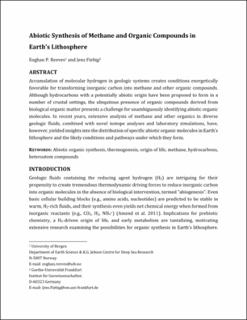| dc.contributor.author | Reeves, Eoghan | |
| dc.contributor.author | Fiebig, Jens | |
| dc.date.accessioned | 2021-08-06T09:29:54Z | |
| dc.date.available | 2021-08-06T09:29:54Z | |
| dc.date.created | 2021-01-07T17:04:14Z | |
| dc.date.issued | 2020 | |
| dc.identifier.issn | 1811-5209 | |
| dc.identifier.uri | https://hdl.handle.net/11250/2766760 | |
| dc.description.abstract | Accumulation of molecular hydrogen in geologic systems can create conditions energetically favorable to transform inorganic carbon into methane and other organic compounds. Although hydrocarbons with a potentially abiotic origin have been proposed to form in a number of crustal settings, the ubiquitous presence of organic compounds derived from biological organic matter presents a challenge for unambiguously identifying abiotic organic molecules. In recent years, extensive analysis of methane and other organics in diverse geologic fluids, combined with novel isotope analyses and laboratory simulations, have, however, yielded insights into the distribution of specific abiotic organic molecules in Earth’s lithosphere and the likely conditions and pathways under which they form. | en_US |
| dc.language.iso | eng | en_US |
| dc.publisher | Mineralogical Society of America | en_US |
| dc.title | Abiotic synthesis of methane and organic compounds in Earth’s lithosphere | en_US |
| dc.type | Journal article | en_US |
| dc.type | Peer reviewed | en_US |
| dc.description.version | acceptedVersion | en_US |
| dc.rights.holder | Copyright 2020 Mineralogical Society of America | en_US |
| cristin.ispublished | true | |
| cristin.fulltext | postprint | |
| cristin.qualitycode | 1 | |
| dc.identifier.doi | 10.2138/gselements.16.1.25 | |
| dc.identifier.cristin | 1867299 | |
| dc.source.journal | Elements | en_US |
| dc.source.pagenumber | 25-31 | en_US |
| dc.identifier.citation | Elements. 2020, 16(1), 25-31 | en_US |
| dc.source.volume | 16 | en_US |
| dc.source.issue | 1 | en_US |
